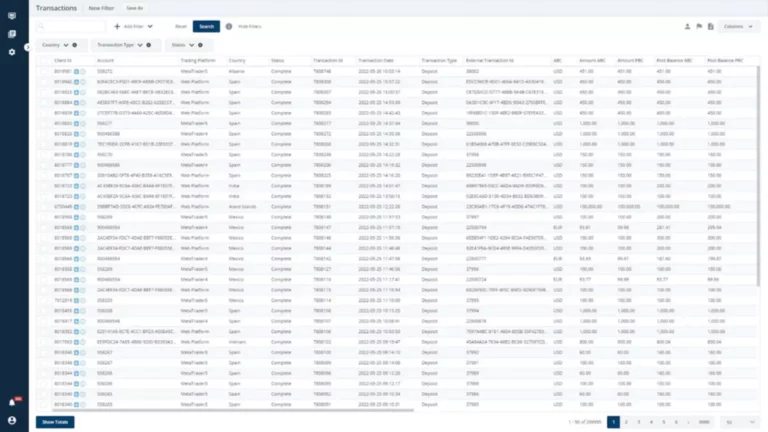Why do big data technologies matter? Fusion Alliance
Content
Big data and its subsequent analysis are helping organizations break through barriers in customer servicing as well as product management and creation. To this effect, companies can also create compelling visual models and sturdy strategies to go hand-in-hand with organizational goals and objectives. The key to revealing the optimal potential of big data will lie in the hands of companies. An in-depth understanding of data and its value as a currency can help stakeholders design the roadmap to Peer-to-peer success. Big supply chain analytics uses big data and quantitative methods to enhance decision-making processes across the supply chain.
What is big data in simple words?
Today, when we gather all the data, we do not need to know beforehand what we plan to use it for. Of course, it might not always be possible to collect all the data, but it is getting much more feasible to capture vastly more of a phenomenon than simply a sample and to aim for all of it. Big data is a matter not just of creating https://www.xcritical.com/ somewhat larger samples but of harnessing as much of the existing data as possible about what is being studied. Data can help retailers know how many three-ring binders to add to inventory before back-to-school shopping begins and inform logistics companies about most efficient delivery routes. Data science tends to be a broader term, while analytics tends to focus specifically on business applications, which is our focus.
Big Data Analytics: The Engine of Business Growth
Inconsistent flow of data, where the data’s meaning or structure can change rapidly. “What was a huge data set for one tool a couple of years ago might be a totally tractable data set on a laptop with a different tool today.” “The concept of the data set alone being the determinate of whether it counts as Big Data is maybe one that was more appropriate three or four years ago,” said Alex Bakker, principal analyst business analytics instrument at Information Services Group. Technology had to come a long way before it was ready for Big Data in its current form.
How is intelligent automation adding value to the Oil and Gas industry?
- One of the primary benefits of big data in UX design is that it enables designers to make informed design decisions that are based on real-world data.
- For instance, retailers can use historical purchasing data to predict which products are likely to sell best during different seasons or events.
- These solutions support businesses with real-time insights, foresight, and visualization, providing advanced decision-making capabilities.
- Initially, as the Hadoop ecosystem took shape and started to mature, big data applications were primarily used by large internet and e-commerce companies such as Yahoo, Google and Meta, as well as analytics and marketing services providers.
- Technology had to come a long way before it was ready for Big Data in its current form.
- In addition, this information often is created and changed at a rapid rate (velocity) and has varying levels of data quality (veracity), creating further challenges on data management, processing and analysis.
The three biggest challenges cited by business leaders included constantly changing data (44%), volume of data (43%), and dealing with inaccuracies in data (40%). Of the leaders that cited data analysis as their biggest challenge, 57% said they planned to hire a data analyst this year. It’s a given that organizations are going to collect too much data, but real value comes from applying advanced analytics to contribute to a company’s ROI.

When done effectively, data analytics becomes a strategic asset that transforms big data into measurable business success. Traditional analytics methods are often insufficient for dealing with the complexity and scale of big data. To maximize the ROI of data analytics, businesses should leverage advanced analytics tools such as machine learning, artificial intelligence (AI), and predictive analytics.

The evolution of both public cloud and hybrid cloud infrastructures will no doubt progress as organizations seek the economic and technical advantages of cloud computing. Whether it’s optimizing operations, enhancing customer experiences, or innovating new products, big data analytics paves the way for smarter and more effective business practices. Organizations may harness their data and utilize big data analytics to find new possibilities.
For instance, an e-commerce platform can use big data analytics to deliver personalized product recommendations based on a customer’s browsing and purchase history, leading to increased sales and customer loyalty. Big data analytics involves massive amounts of data in various formats, including structured, semi-structured and unstructured data. Big data analytics employs advanced techniques like machine learning and data mining to extract information from complex data sets. It often requires distributed processing systems like Hadoop to manage the sheer volume of data. In addition to innovations in cloud storage and processing, enterprises are shifting toward new data architecture approaches that allow them to handle the variety, veracity and volume challenges of big data. Rather than trying to centralize data storage in a data warehouse that requires complex and time-intensive extract, transform and load processes, enterprises are evolving the concept of the data lake.
Big data refers to the massive volume of structured and unstructured data generated from various sources, including social media, sensors, transaction records, and more. The value of big data is not in its sheer volume but in the insights that can be derived from it. Big data analytics is the key to achieving this level of personalization, as it allows businesses to analyze vast amounts of customer data and provide customized experiences based on individual needs and preferences.
Addressing these challenges requires a commitment to collecting and analyzing high-quality data, balancing quantitative and qualitative data, and ensuring adequate attention to the human element of design. By leveraging big data in UX design, designers can make more informed decisions and optimize user experiences. Big data lets designers identify potential issues before they become significant problems. It also enables them to create more personalized and engaging user experiences that meet users’ needs and preferences. The use of devices for distributed processing is embodied in the concept of edge computing, which shifts the processing load to the devices themselves before the data is sent to the servers. Edge computing optimizes performance and storage by reducing the need for data to flow through networks.

Finally, businesses must measure the impact of their data analytics initiatives to ensure they are driving tangible results. This involves setting clear, measurable objectives for data analytics projects and tracking key performance indicators (KPIs) such as revenue growth, cost savings, customer satisfaction, and operational efficiency. Big Data analytics is a process used to extract meaningful insights, such as hidden patterns, unknown correlations, market trends, and customer preferences. Big Data analytics provides various advantages—it can be used for better decision making, preventing fraudulent activities, among other things. Although the idea of identifying potential wrongdoers before they have committed a crime seems fanciful, big data has allowed some authorities to take it seriously.
The more devices that connect to the internet, the more data we generate; therefore, the more people who are needed to interpret that data. Brands may easily provide customers with what they want by using analytics to reduce the guesswork involved in product creation. The market is segmented into software, hardware, and services based on components.
The increasing digital solutions across business sectors, such as banking, healthcare, BFSI, retail, agriculture, and telecom/media, significantly increase data. For instance, artificial intelligence brings a noteworthy change in the agriculture sector’s risk management, precision farming, and pest control. The increase in connected IoT devices volume is owing to the surging adoption of Machine Learning (ML) algorithms, the Internet of Things (IoT), and Artificial Intelligence (AI). According to the International Data Corporation (IDC) data, 152,200 IoT devices will connect per minute by 2025.
A number of other trends have also started to appear, such as pairing generative AI with big data analytics. Big data analytics applications often include data from both internal systems and external sources, such as weather data or demographic data on consumers compiled by third-party information service providers. In addition, streaming analytics applications are becoming more common in big data environments as users perform real-time analytics on data fed into Hadoop systems through stream processing engines, such as Spark, Flink and Storm.


